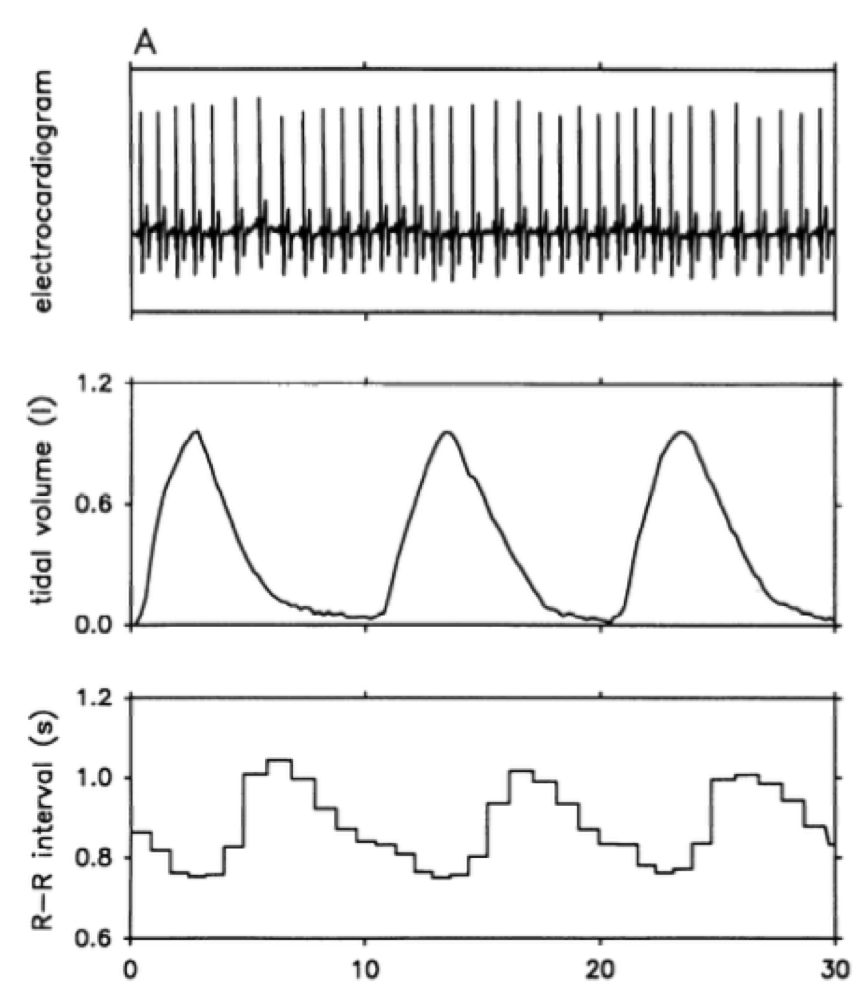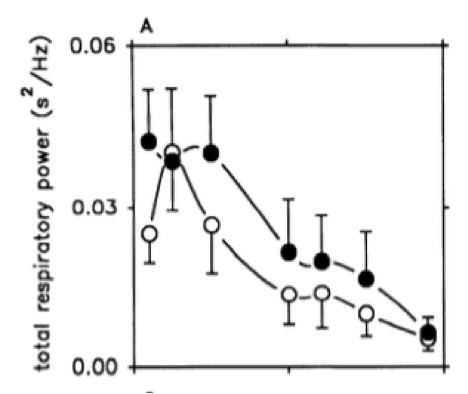Who, what & why?
By the early 1990s, a number of studies had started to form important conclusions about how HRV signaled different bodily states, including mental stress and chances of survival following a heart attack. Although several of these had stated that breathing influenced the results, researchers at the Dept of Veterans Affairs Medical Center in Virginia USA were not happy about how few of these controlled breathing rate and depth. This brought into question the validity of their results, as well as whether other researchers would be able to reproduce them.
This was becoming more important since the newly developed frequency domain analysis was able to identify different components of HRV. This group of researchers, led by eminent physiologist Dwain Eckberg, who has authored more than twenty papers on HRV, decided to conduct some elegantly simple experiments to determine the influence of both breathing rate and depth (also known as tidal volume) on HRV.
I wanted to summarize this paper because it was the first one to really unravel the relationship between breathing and HRV systematically.
What did they do?
The researchers wired up 9 young adult volunteers to an ECG and a breathing apparatus that would measure how much air was flowing as well as the CO2 level in the expired air. Controlling CO2 concentration is important because it is this that triggers us to breathe, rather than a lack of oxygen. Breath pacing was achieved using sound cues at rates of between 6 and 24 breaths per minute, and the volunteers were asked to maintain breathing depth at either 1L or 1.5L depending on the test.
They started a test sequence at the lowest breathing rate of 6 breaths per minute, and other rates & depths were then set at random during a 2 min test.
Measures derived from the ECG included high frequency, low frequency and total power of HRV.
What did they find?
The paper has some great plots, which illustrate the fundamentals of what happens to heart rate when we breathe in & out:

The first thing they found was a well-defined relationship between the phase of breathing and the beat-to-beat (R-R) interval. The lower two traces show that as we breathe in (tidal volume increasing), the RR interval gets smaller, and heart rate therefore increases. Conversely when exhaling, the tidal volume decreases, and heartbeat interval increases (HR therefore decreases).
The next thing they found was that the total amount of variation between heart beats (HRV) depended on both breathing rate and depth (volume):
![]()
Breath rates 6, 7.5, 10, 12.5, 15, 17, 20, 24 breaths / minute
You can see that the amount of HRV at the 3 lowest rates of 6, 7.5 and 10 breaths per minute was much higher than that at rates of 15 breaths per minute and above. As expected, the amount of HRV was higher at the deeper breathing volumes, though its interesting to note that the higher volume seemed to saturate HRV at the lower breathing rates, whereas the lower volume HRV peaked at 7.5 breaths / min.
Finally, they also found that average heart rate was not affected by either breathing rate or depth.
What does it mean?
The most significant findings from this landmark study are:
- Breathing rate and depth strongly influence HRV.
A consequence of this is that relatively small changes in natural breathing rates, in the region between 7.5-15 breaths per minute, can cause quite significant changes in measured HRV.
- The breathing rate and depths used did not alter the net amount of autonomic sympathetic or parasympathetic tone.
So in other words, carefully designed paced breathing need not cause stress or alter the autonomic state of the person being measured.
The authors finally concluded that respiration parameters strongly influenced HRV and further recommended that respiration must be controlled in order to interpret HRV power spectra.
Physiologists have puzzled over the evolutionary origin and advantage that this heart rate variation confers. For a long time it was thought that having a higher HR when your lungs are full of air might improve oxygen absorption, and it would therefore need to slow down again when breathing out. More recently though, detailed calculations have shown that this breathing dependent HRV is slightly more energy efficient than keeping a constant rate, a marginal gain that we sometimes lose sight of nowadays when food (for many humans at least) is plentiful.
This was one of the papers we reviewed carefully when designing ithlete back in 2009, and led to our decision to employ paced breathing at 7.5 breaths per minute in order to maximize HRV at breathing rate, but without disturbing the body’s underlying autonomic balance that we are seeking to measure.
So there you have it, the research behind the paced breathing element of the ithlete app!
By Simon Wegerif
References
Important influence of respiration on human R-R interval power spectra is largely ignored: TROY E. BROWN, LARRY A. BEIGHTOL, JUNKEN KOH, AND DWAIN L. ECKBERG. Departments of Medicine and Physiology, Hunter Holmes McGuire Department of Veterans Affairs Medical Center and Medical College of Virginia, Richmond, Virginia 23249

